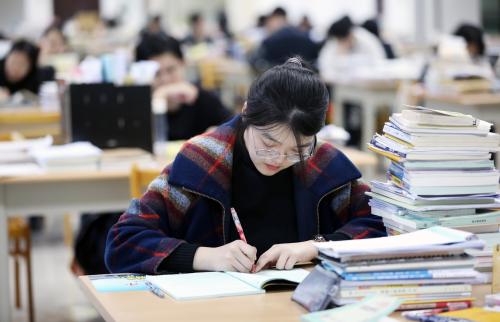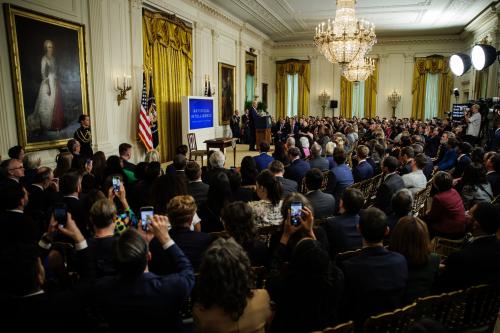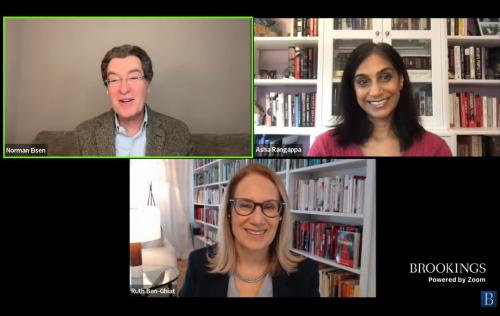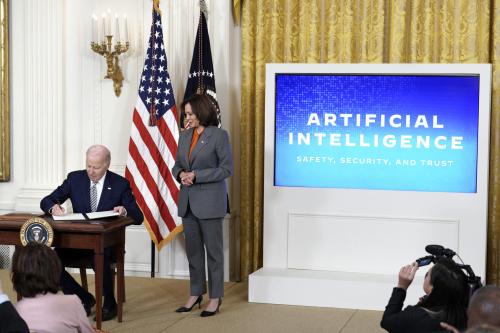The United States and China are vying for global leadership in artificial intelligence (AI), with the United States holding a key advantage: its attractiveness to Chinese talent. Yet, this appeal is under threat by security policies that alienate Chinese scientists and immigration policies that restrict the flow of talent.
Nearly one in two top AI researchers is from China
With many of the leading AI companies based in the United States—ranging from established giants like Microsoft to innovative upstarts like OpenAI—one might assume that American leadership in this industry is secure. Yet, most do not recognize the role that Chinese nationals contribute to these prominent U.S. companies. This oversight highlights how the United States’ global dominance in AI may be more fragile than assumed.
Of course, many industry analysts have long recognized that many Chinese students complete their undergraduate education in China and go to the United States for graduate school, subsequently opting to work for American companies. For example, Jing Li is a core member of both Sora and DALL.E—the two OpenAI products in addition to ChatGPT. She received her undergraduate degree in physics from Peking University before earning a Ph.D. from MIT. This is the first way in which China’s substantial contribution to the AI industry is often obscured.
Recently, Macro Polo released its updated report on the top AI researchers using data from 2022, comparing it with results from 2019. The report defines “the top AI researchers” as authors of papers selected for the NeurIPS conference, which represent the top 20 percent of AI research. To illuminate these cross-country talent flows, the report assigns researchers to countries based on the location of their undergraduate education. This methodology revealed that China produced 47 percent of the top AI talent in 2022, far surpassing the United States (ranked second), which accounted for 18 percent of the top AI talent.
These figures could even be an underestimate for China, and an overestimate for the United States, as some Chinese students pursue undergraduate studies in the United States and thus get counted under the U.S. contribution. Ricky Wang, a member of the core technology team for Sora, exemplifies this second way China’s contribution stays hidden. Wang, born and raised in China, completed his high school education in Nanjing in 2013 and his undergraduate studies at Berkeley in 2016. Since 2014, Chinese undergraduates have outnumbered graduate students and have become the mainstay of Chinese students in the United States, with computer science being one of the top majors they choose, among other science, technology, engineering, and mathematics (STEM) fields.
It is unclear how many individuals like Li and Wang work in American companies or what their preferences are for staying in the United States or returning to China over the long term. Regardless, their presence suggests that viewing AI competition strictly through a geopolitical lens may overshadow the significance of talent mobility. Moreover, with this backbone of talent originating from China, America’s position as a frontrunner in AI is far less secure than many assume.
Why the United States depends on foreign talent in technology
The prominence of Chinese talent in AI is not surprising, given the foundational role of mathematics, particularly linear algebra, in AI, and the fact that American students have fallen behind in STEM fields. AI was ranked as the most popular major for three consecutive years from 2020-2023 in China, while in the United States, business is the most popular major.
The COVID-19 pandemic disrupted American students’ mathematics education even further. A report released on March 13 from the National Science Board (NSB) found that “the vast majority” of eighth graders scored below proficiency in the National Assessment of Educational Progress math assessment from 2020-2023. The NSB has labeled this situation a “STEM talent crisis” and has called for “dramatically and quickly improving the STEM education trajectories for over 54 million primary and secondary school students.” While the call is undoubtedly needed, the barriers are entrenched in both structural and cultural aspects.
Structurally, the American education system—particularly at the K-12 level—is segregated and unequal and fails to prepare students for foundational subjects such as math. The highly differentiated curriculum track placing students into tracks from honors to remedial, however, serves the privileged and leaves a large majority of American students from humble beginnings behind. Research has shown that Black, Latino, and low-income students are systematically assigned to low-level tracks, which often start from middle school or even earlier. Given that math courses are sequential, the cumulative disadvantages are profound. This is coupled with the teacher shortage in math and science, which makes American K-12 education structurally unfit for a STEM career path.
Even if students enroll in college, they are woefully unprepared for demanding college math coursework. Up to 65 percent of community college students need to take at least one remedial course that is not college-level, and a disproportionate share of these students are racial minority and low-income students. This talent crisis does not bode well for the successful delivery of the CHIPS and Science Act, the bipartisan bill passed in Congress last year aimed at maintaining U.S. leadership in science and technology, and the semiconductor industry in particular.
American students’ lack of enthusiasm for STEM education can also be explained by cultural barriers. Learning math and science is unpopular among the American public and research has shown that there is a negative association between self-confidence and math performance. Moreover, not only is a dislike of math socially acceptable, but research shows that Americans hold scientists in high regard but consider the career only for a few gifted minds. This culture of viewing science and tech as belonging to a few nerds and geeks is a formidable barrier to cultivating domestic talent in STEM.
More Chinese AI talent is staying in China
Pushed by the United States’ anti-China policies and pulled by Chinese higher education’s rising stature, more top Chinese AI talent is staying in China. In 2022, 28 percent of top AI researchers were working in China, up from only 11 percent in 2019. While a small number of Chinese students have participated in espionage on behalf of Chinese authorities, treating the entire group with suspicion has morphed into anti-Asian racism, which is not only experienced on the streets and in shopping malls but also in challenges of securing research funding. Asian researchers face the highest rejection rates for National Science Foundation Grant applications—undermining the stereotypical argument of Asian exceptionalism in academia—and are increasingly leaving the United States or returning to China as a result.
Advancements in China’s AI higher education are enticing many top Chinese talent to stay in China. The Macro Polo report highlights that only two Chinese universities were ranked among the top 25 institutions for top-tier AI research in 2019. By 2022, this number had risen to six. In 2019, only 10 percent of the most elite AI researchers (top 2 percent) obtained their undergraduate degrees in Chinese universities, compared to 35 percent of those in the United States; in 2022, 26 percent obtained their undergraduate degrees in China, closing the gap with the United States to just 2 percent. This marginal difference could be due in part to those Chinese students who came to the United States for undergraduate education, such as Ricky Wang, although the data has not proven that yet.
America needs immigration reform for the highly skilled
Some may wonder whether the United States should diversify its dependence on foreign talent. Of course, it should. However, there are few alternative sources of AI talent outside of China. While India has overtaken China in the overall number of international students in the United States, it falls significantly short in producing top AI talent, contributing just 5 percent compared to China’s 47 percent. This disparity is largely attributed to the differences in the two countries’ higher education systems: Among the top 25 global institutions recognized for leading AI research, China boasts six such institutions, while India has none.
Fortunately, many U.S.-educated Chinese talent want to stay and work for American companies, especially in the AI industry, as they offer better pay and work-life balance than companies in China. However, U.S. immigration policies create formidable barriers. The tightening of H-1B visa regulations has led to a sharp decline in approval rates, from 46.1 percent in fiscal year 2021 to just 14.6 percent in fiscal year 2024, with Indian applicants securing 70 percent of these visas (in 2021). Considering that the United States has established a comprehensive system to identify foreign agents through visa screenings and law enforcement framework, denying entry to any law-abiding, skilled foreign talent directly undermines America’s capacity for innovation.
Immigration is a hot topic in the 2024 presidential election, yet the focus is predominantly on undocumented migrants at the southern border rather than the highly skilled workers who are integral to American innovation. Immigrants, notably those from the Chinese community, have been instrumental in driving innovation in AI and America’s broader high-tech industry, which suffers from a domestic “talent crisis.” Addressing this challenge demands more favorable immigration policies, particularly in relation to the restrictive H1-B visa lottery system, and a reduction in the hostility faced by Chinese scientists. It is in America’s best interest to reform these systems.
The Brookings Institution is committed to quality, independence, and impact.
We are supported by a diverse array of funders. In line with our values and policies, each Brookings publication represents the sole views of its author(s).








Commentary
US security and immigration policies threaten its AI leadership
April 4, 2024